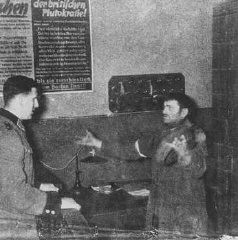You searched for: Ghettos
<< Previous | Displaying results 301-350 of 1235 for "Ghettos" | Next >>
-
Minsk - Maps
Media EssayGerman authorities established a ghetto in Minsk in July 1941, shortly after German forces occupied the city. About 80,000 Jews were initially crowded into the ghetto, with 24,000 more people deported there later that year. In August 1941, the Germans began mass killing operations against the residents of the ghetto.

-
Warsaw (Abridged Article) - Historical Film Footage
Media EssayDuring World War II, the Germans established ghettos where Jews were forced to live in miserable conditions. In October 1940, a ghetto was established in Warsaw, Poland. Before the war, Warsaw had the largest Jewish community in Europe. At its hei...
-
Hungary after the German Occupation
ArticleThe Nazis invaded Hungary in 1944 to prevent the government from negotiating an armistice with the Allies. Learn more about conditions in occupied Hungary.

-
Estelle Laughlin
ArticleExplore Estelle Laughlin’s biography and learn about her experiences during the Warsaw ghetto uprising.
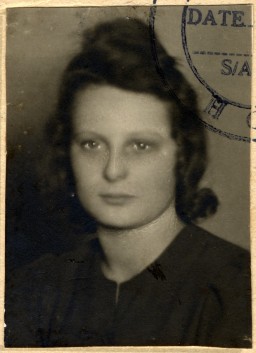
-
Dutch Jews in Theresienstadt
PhotoDutch Jews who have recently arrived in the Theresienstadt ghetto. Czechoslovakia, February 1944.

-
An elderly Jewish woman wearing the compulsory Jewish badge
PhotoPortrait of an elderly Jewish woman wearing a Jewish badge in the Olkusz ghetto. Olkusz , Poland, 1941.
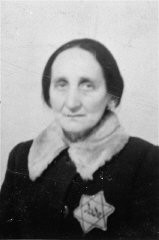
-
Warsaw: Maps
Media EssayDuring World War II, the Germans established ghettos where Jews were forced to live in miserable conditions. In October 1940, a ghetto was established in Warsaw, Poland. Before the war, Warsaw had the largest Jewish community in Europe. At its heigh...
-
Chaya Medalion
ID CardChaya and her brother and two sisters were raised in a religious, Yiddish-speaking home in the town of Kozienice, situated in east central Poland near a large birch forest. As a child, Chaya learned Hebrew. She attended Polish public schools and graduated at 14. Her father owned a factory that produced handmade shoes. 1933-39: Chaya was active in the Zionist movement, through which she met her boyfriend, Lewek Szabasson. Chaya and Lewek would stroll on Kozienice's main promenade which was at the…
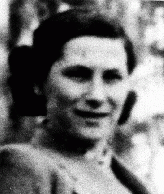
-
Benjamin Frydmacher
ID CardBenjamin was born in the industrial city of Lublin to a large, Yiddish-speaking Jewish family. He attended public school, and after he graduated at the age of 14, he apprenticed at the same tannery where his father was the tannery master. 1933-39: After completing his apprenticeship, Benjamin became the assistant tannery master. After his father's death in 1938, he became the production tannery master. He and his wife, Gucia, lived with his mother at 50 Lubartowska Street. In 1938 the Frydmachers had a…
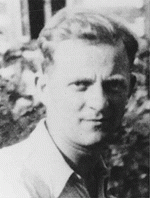
-
Page from the Stroop Report
PhotoA page from SS officer Juergen Stroop's report on the Warsaw ghetto uprising. He wrote: "This is what the former Jewish residential quarter looks like after its destruction." Warsaw, Poland, April-May, 1943.

-
Moishe Menyuk
ID CardMoishe was born to a Jewish family in the village of Komarovo, which until 1918 was part of the Russian Empire. At 18, he was drafted into the Russian army and fought in World War I. He was captured by the Germans, and while a POW, learned German. After the war he returned to Komarovo, which by then was part of Poland. He supported his family by farming and managing an estate for a Pole from Warsaw. 1933-39: The few Jews of Komarovo got along well with the Ukrainians. Moishe even played the fiddle at…

-
Women during the Holocaust
ArticleUnder the Nazis, Jewish and other “non-Aryan” women were often subjected to brutal persecution. Learn more about the plight of women during the Holocaust.
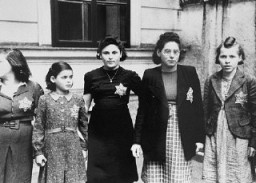
-
Rojske Kisielnicki Sadowsky
ID CardThe second of three children, Rojske was born to Jewish parents living 35 miles east of Warsaw in the small predominantly Jewish town of Kaluszyn. Rojske's mother was a housewife and her father was a merchant who often traveled, by horse and wagon, to Warsaw on business. When Rojske was in her twenties, she married Welwel Sadowsky, a fruit dealer. 1933-39: After war broke out last week, German forces fought Polish troops in a battle right here in Kaluszyn. Half the town has been flattened by shelling, and…

-
Iosif Rivkin
ID CardIosif was born to a Jewish family in the Belorussian capital of Minsk. He fought with the Tsarist troops in World War I and was taken prisoner by the Germans. When he returned to Minsk after the war, he began working in a state-owned factory building furniture, an occupation in which a number of his relatives also made a living. 1933-39: By the early 1930s, Iosif was married and had three daughters, Hacia, Dora and Berta. The family lived on Novomesnitskaya Street in central Minsk, near the Svisloch…
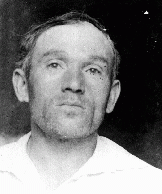
-
Bella Jakubowicz Tovey describes a meeting between her father and the Jewish council leader in Sosnowiec
Oral HistoryBella was the oldest of four children born to a Jewish family in Sosnowiec. Her father owned a knitting factory. After the Germans invaded Poland in 1939, they took over the factory. The family's furniture was given to a German woman. Bella was forced to work in a factory in the Sosnowiec ghetto in 1941. At the end of 1942 the family was deported to the Bedzin ghetto. Bella was deported to the Graeben subcamp of Gross-Rosen in 1943 and to Bergen-Belsen in 1944. She was liberated in April 1945.

-
Chaia Gurvitz
ID CardFrom a Jewish family, Chaia lived outside Kovno, a city with a large Jewish population that was renowned for its Hebrew school system. Chaia ran a grocery store with her husband, a retired shoemaker, and their daughter Yenta. 1933-39: Chaia is expecting her daughter Feiga, Feiga's husband, Josef, and her grandson, Abraham, for dinner. Feiga works so hard all week in her beauty shop, Chaia is glad she can help out by preparing the big Sunday meal. She has baked a special cake for Abe. Chaia hopes the…

-
Arthur Menke
ID CardArthur was born to a Jewish family in Germany's largest port city, Hamburg. His father owned a small factory that manufactured rubber stamps. In the early 1930s, Hamburg was home to the fourth largest Jewish community in Germany, which had numerous social and cultural institutions. 1933-39: By 1935 conditions for Hamburg's Jews were bad. Arthur's family was moved to another part of town and in 1938, the Nazis seized his father's business. On national holidays many German citizens unfurled red, white and…
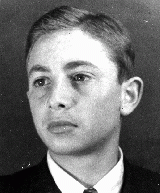
-
Welwel Wainkranc
ID CardThe third of five brothers, Welwel was born to Jewish parents who lived 35 miles east of Warsaw in the small predominantly Jewish town of Kaluszyn. His father was a cattle merchant who purchased cows and sold the meat to butchers in the Warsaw region. Welwel spent most of his free time with a group of Jewish friends who lived in his neighborhood and who attended the same public school. 1933-39: Every summer evening Welwel, Abram Kisielnicki, and some other pals, like to stroll along Kaluszyn's main…

-
Lewek Szabasson
ID CardLewek and his five brothers and sisters were born to religious Jewish parents in the town of Kozienice, situated in east central Poland near a birch forest. Lewek's father owned a sawmill, and when Lewek and his brothers were grown, they helped their father manage the family business. 1933-39: When Lewek was 15 he attended an agricultural school near Kozienice, because he wanted to immigrate to Palestine [Aliyah] to work the land. But after the Nazis rose to power in Germany in 1933, immigration…

-
Cecilie Klein-Pollack describes deportation from Huszt
Oral HistoryCecilie was the youngest of six children born to a religious, middle-class Jewish family. In 1939, Hungary occupied Cecilie's area of Czechoslovakia. Members of her family were imprisoned. The Germans occupied Hungary in 1944. Cecilie and her family had to move into a ghetto in Huszt and were later deported to Auschwitz. Cecilie and her sister were chosen for forced labor; the rest of her family was gassed upon arrival. Cecilie was transferred to several other camps, where she labored in factories. Allied…
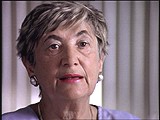
-
Max Gutmann
ID CardMax was raised in the Romanian town of Radauti, a trading and woodworking center near the Ukrainian border. The Gutmanns had a traditional Jewish home, and Max's father was on the board of directors of the local Jewish community. Max's father dealt in grain, feed, and livestock and he was a purveyor of horses for the Romanian military. 1933-39: Max's pony, Lisa, was kept in his family's stables with the other horses. The secondary school he attended was semi-private; it was governed by the state, but each…
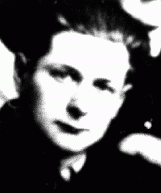
-
Herschel Gerszonowicz
ID CardThe fourth of eight children, Herschel was born to Jewish parents in south central Poland. His father was a machinist and locksmith. Herschel belonged to the Zionist youth organization, Ha Shomer ha-Tsa'ir, and played soccer for the Jewish team. When he was 14 years old, he left school to become apprenticed to his stepsister's father who was a tailor. 1933-39: Herschel was working as a tailor in Miechow when, on September 1, 1939, the German army invaded Poland. His parents decided that he and his…

-
Haika Grosman
PhotoHaika Grosman, one of the organizers of the Bialystok ghetto underground and participant in the Bialystok ghetto revolt. Poland, 1945.
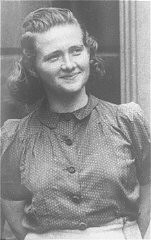
-
Deserted street in Sighet Marmatiei
PhotoA deserted street in the area of the Sighet Marmatiei ghetto. This photograph was taken after the deportation of the ghetto population. Sighet Marmatiei, Hungary, May 1944.

-
Jewish Councils (Judenraete) - Photographs
Media EssayThe Germans established Jewish Councils (Judenraete) in the ghettos during World War II. Jewish Councils were required to implement Nazi policies in the ghettos. This role meant impossible moral dilemmas. Council members had to decide whe...
-
Mordechai Chaim Rumkowski
PhotoMordechai Chaim Rumkowski, Jewish council chairman in the Lodz ghetto, seen here speaking amongst Jewish ghetto policemen. Lodz, Poland, ca. 1942.

-
Deportation of Jews from Warsaw
PhotoDeportation of Jews from the Warsaw ghetto. Jews from the ghetto board a deportation train with the assistance of Jewish police. Warsaw, Poland, 1943.
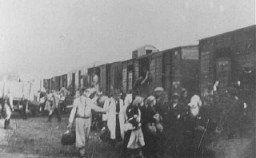
-
Deportation from Warsaw
PhotoDeportation of Jewish women from the Warsaw ghetto. Poland, 1942-1943.
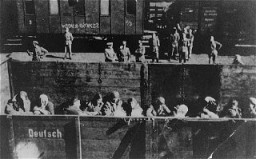
-
Deportation from Szeged
PhotoJewish residents of the Szeged ghetto assemble for deportation. Szeged, Hungary, June 1944.

-
Deportation of Jews from Prague
PhotoJews deported from Prague, Czechoslovakia, move their belongings through the streets of the Lodz ghetto in occupied Poland. November 20, 1941.
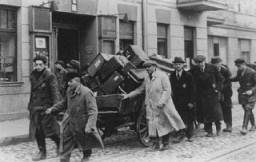
-
Death penalty decree
PhotoA Nazi decree issued in October 1941, in German and Polish, warns that Jews leaving the ghetto, or Poles who aid them, will be executed. Czestochowa, Poland.
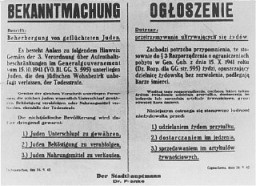
-
Minsk resistance leader Mikhael Guebelev
PhotoMikhael Guebelev, organizer of the underground group in the Minsk ghetto. Soviet Union, date unknown.
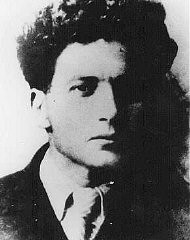
-
Mordechai Chaim Rumkowski
PhotoLodz ghetto Jewish council chairman Mordechai Chaim Rumkowski delivers a speech. Lodz, Poland, 1941–43.
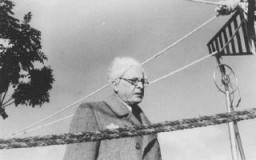
-
Lodz - ID Cards/Oral Histories
Media EssayGerman troops occupied Lodz one week after Germany invaded Poland in September 1939. In early 1940, the Germans established a ghetto in the northeast section of the city. More than 20 percent of the ghetto's population died as a direct result of i...
-
Listing of Jews for deportation to Riga, Latvia
DocumentThe SS compiled lists of Jews who were to be deported to ghettos, concentration camps, and killing centers. This document provides the names, birthdates, marital status, and addresses of Jews who were “evacuated” on November 20, 1941 from Germany to the Riga ghetto in German-occupied Latvia.
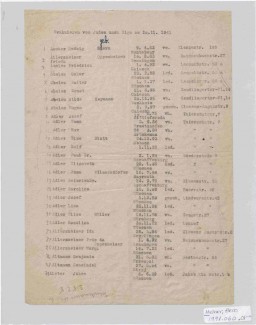
-
Warsaw (Abridged Article) - ID Card/Oral History
Media EssayThe Germans established a ghetto in Warsaw in October 1940. All Jewish residents were required to live in the ghetto, which was sealed off from the rest of the city. Overcrowding, minimal rations, and unsanitary conditions led to disease, starvati...
-
Warsaw - ID Card/Oral History
Media EssayThe Germans established a ghetto in Warsaw in October 1940. All of Warsaw's Jews were required to live in the ghetto, which was sealed off from the rest of the city. Overcrowding, minimal rations, and unsanitary conditions led to disease, starvati...
-
An emaciated woman selling Star of David armbands
PhotoAn emaciated woman sells the compulsory Star of David armbands for Jews. In the background are concert posters; almost all are destroyed. Warsaw ghetto, Poland, September 19, 1941. This photograph was taken by Heinrich Joest, a German army sergeant during World War II. On September 19, 1941, he took 140 images of every aspect of life and death in the Warsaw ghetto.
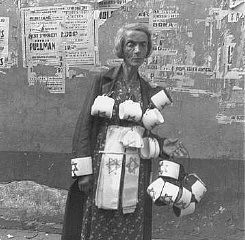
-
Children during the Holocaust
ArticleChildren were especially vulnerable to Nazi persecution. Learn more about the fates of Jewish and non-Jewish children.

-
Lodz - Animated Maps/Maps
Media EssayGerman troops occupied Lodz one week after Germany invaded Poland in September 1939. In early 1940, the Germans established a ghetto in a small area in the northeast section of the city.
-
Alice (Lisl) Winternitz's luggage tag
ArtifactThis paper tag identified bedding belonging to Alice (Lisl) Winternitz when she was deported from Prague, Czechoslovakia, to the Theresienstadt ghetto in June 1942.
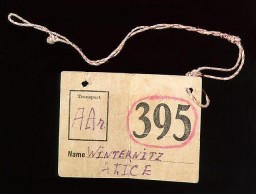
-
White armband with blue Star of David
ArtifactWhite armband with a Star of David embroidered in blue thread, worn by Dina Offman from 1939 until 1941 while in the ghetto in Stopnica, Poland.
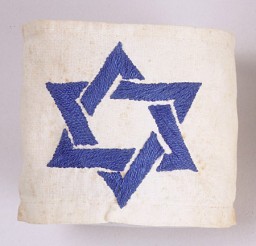
-
White armband with blue Star of David
ArtifactWhite armband with a Star of David embroidered in blue thread, worn by Dina Offman from 1939 until 1941 while in the ghetto in Stopnica, Poland.
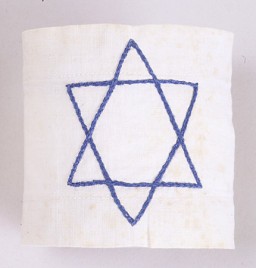
-
Scene from a Nazi propaganda film in Theresienstadt
PhotoIn a scene from a Nazi propaganda film, Dr. Paul Eppstein (right), Council of Elders chairman, addresses Dutch Jews. Theresienstadt ghetto, Czechoslovakia, August 1944.

-
Cover of an underground Yiddish newspaper
PhotoCover of an underground Yiddish newspaper, Jugend Shtimme (Voice of Youth). Writing on the bottom of the cover reads: "Fascism must be smashed." Warsaw ghetto, Poland, January–February 1941.
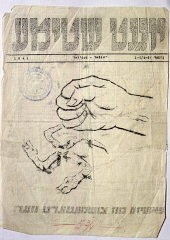
-
Family members say goodbye to a child
PhotoFamily members say goodbye to a child through a fence at the ghetto's central prison where children, the sick, and the elderly were held before deportation to Chelmno during the "Gehsperre" action. Lodz, Poland, September 1942.

-
Warning sign in German and Latvian
PhotoA sign, in both German and Latvian, warning that people attempting to cross the fence or to contact inhabitants of the Riga ghetto will be shot. Riga, Latvia, 1941–43.
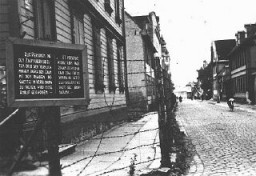
-
German policeman interrogates a Jewish man accused of smuggling
PhotoA German policeman interrogates a Jewish man accused of trying to smuggle a loaf of bread into the Warsaw ghetto. Warsaw, Poland, 1942-1943.
